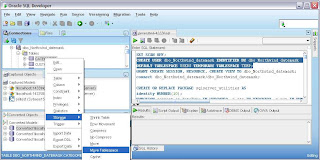Using Regular Expression To Resolve Multiple Issues
One way to resolve issues which occur too many times to fix by hand in the generation script is to use a regular expression to search and replace some problematic code. Shiva Ramakrishnan provided these regular expressions \(['][A-Za-z_ ]*\)& ----------------à \1'||chr(38)||' \(['][A-Za-z_ ]*\)& \([A-Za-z_ ]*[']\)--------------------------à \1'||chr(38)||'\2 \(raw(\)\([0-9]*\)\() default 0\) ----------------------------------à \1\2) default '0' \('12/31/9999'\) -------------------------------------------à to_date(\1,'mm/dd/yyyy') CAST('9999-12-31' AS DATE) ----------àto_date(‘12/31/9999’,’mm/dd/yyyy’) First one is replacing ‘&’ with CHR(38). SQLPLUS provides mechanism to overlook this. So this is not a major concern. The second one is where RAW datatypes are assigned DEFAULT 0. I am reassigning with DEFAULT ‘0’ The third is a case of DATE Fields assigned as is. I think NLS_DATE parameters can be SET to overlook t




